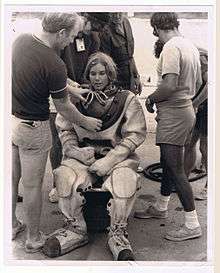Anne Rudloe
| Anne Eidemiller Rudloe | |
|---|---|
 Picture of Anne Eidemiller Rudloe at the U.S. Naval base in Panama City in the underwater research and diving techniques as part of the "Scientists in the Sea" program. | |
| Born |
December 24, 1947 Troy, Ohio, U.S. |
| Died |
April 27, 2012 (aged 64) Panacea, Florida, U.S. |
| Residence | Panacea, Florida, U.S. |
| Nationality | American |
| Fields | Marine biology |
| Institutions | Panacea Institute of Marine Science, Gulf Specimen Marine Laboratory |
| Alma mater | Mary Washington College, Florida State University |
| Notable awards | National Wetlands Award |
 | |
|
| |
|
|
Anne Rudloe (née Eidemiller, December 24, 1947 – April 27, 2012) was an American marine biologist. She was the co-founder of the Gulf Specimen Marine Laboratory in Panacea, Florida.

Biography
Rudloe was born Anne Eidemiller, December 24, 1947 in Troy, Ohio, and grew up in Hampton, Virginia. In 1971, she married writer and naturalist Jack Rudloe.[1][2][3]
She earned a BSc (Biology) at Mary Washington College in 1969. She received an MSc in Oceanography from Florida State University in 1972 for Significant associations of the motile epibenthos of the turtle-grass beds of St. Joseph Bay, Florida.[4] She received a PhD in Marine Biology in 1978 working with William F. Hernkind at Florida State University for Some ecologically significant aspects of the behavior of the horseshoe crab Limulus polyphemus.[5] She trained at the United States Naval base in Panama City in underwater research and diving techniques in the "Scientists in the Sea" program and was the first woman to complete the program. She was an FSU adjunct professor of biological science. In 1980 she founded the Panacea Institute of Marine Science in Panacea, Florida.[2] In 1990, she co-founded the Gulf Specimen Marine Laboratory,[6] as a non-profit teaching laboratory of which she was the managing director.[3][7]
Rudloe published five books, in addition to scientific articles on horseshoe crabs, electric rays, mysid shrimp, and sea turtles. She wrote for a larger audience as well,[8] in publications such as National Geographic, Smithsonian Magazine, Sports Illustrated, Natural History and Audubon. The article "Trouble in Bayou Country" (National Geographic 182 (September 1979): 377–9), which she co-wrote with her husband, is frequently cited in accounts of environmental damage to the Atchafalaya Basin.[9][10]
Rudloe also studied Zen Bhuddism and received INGA (Dharma transmission) to teach as a JDPSN (Jido Pope Sanim) in the Kwan Um School of Zen. She then became the Abbot at the Cypress Tree Zen Center in Tallahassee, Florida.[1] She was a frequent guest contributor for National Public Radio for both her conservation efforts and Zen Bhuddism.[1]
She died of colon cancer, April 27, 2012.[11][12][13] Rudloe was posthumously honored by the Environmental Law Institute with the 2014 Education and Outreach/National Wetlands award.[2][14]
Selected works
| Library resources about Anne Rudloe |
| By Anne Rudloe |
|---|
- Butterflies on a sea wind: beginning Zen (2002)
- Chicken Wars (fiction, 2006, with Jack Rudloe)
- Priceless Florida: natural ecosystems and native species (2004, with E. Whitney and D.B. Means)
- Shrimp: the endless quest for pink gold (2010, with Jack Rudloe)
- Zen in a Wild Country (2012)
- "The Suwannee, Our Wild and Scenic Rivers" in National Geographic Vol. 152, No. 1, July, 1977 (with Jack Rudloe)
References
- 1 2 3 "Anne Rudloe Obituary". Wakulla News. May 2, 2012. Retrieved Feb 20, 2015.
- 1 2 3 "Alumna Writes, Lives, Researches Florida Ecology". MWC Today. University of Mary Washington. Spring 1983. pp. 7–8. Retrieved February 20, 2015.
- 1 2 Bettendorf, Elizabeth (Summer 2009). "A Place, A Purpose, A Panacea" (PDF). Florida State University Research Review. pp. 28–39.
- ↑ Eidemiller, Julia Anne (1972). Significant associations of the motile epibenthos of the turtle-grass beds of St. Joseph Bay, Florida (MS Thesis). Tallahassee, Florida: Florida State University.
- ↑ Rudloe, Anne Eidemiller (1978). Some ecologically significant aspects of the behavior of the horseshoe crab Limulus polyphemus (Dissertation). Tallahassee, Florida: Florida State University.
- ↑ Haloub, Bonnie. "Panacea marine lab celebrates 50 years", Tallahassee Democrat, May 12, 2014, retrieved January 30, 2015.
- ↑ Blaustein, Richard J. (2008). "Biodiversity Hotspot: The Florida Panhandle". BioScience. 58 (9): 784–90. doi:10.1641/b580904. JSTOR 10.1641/B580904.
- ↑ "Articles by Jack and Anne Rudloe". Gulf Specimen Marine Laboratory.
- ↑ Reuss, Martin (1982). "The Army Corps of Engineers and Flood-Control: Politics on the Lower Mississippi". Louisiana History. Louisiana Historical Association. 23 (2): 131–48. JSTOR 4232166.
- ↑ Colten, Craig E. (2002). "Reintroducing Nature to the City: Wetlands in New Orleans". Environmental History. 7 (2): 226–46. doi:10.2307/3985683. JSTOR 3985683.
- ↑ Seidler Productions 2014. "'The Nature of Cancer' with Anne Rudloe". Retrieved February 21, 2015.
- ↑ Orser, Frank (September 2011). "A Guide to the Jack and Anne Rudloe Papers". George A. Smathers Libraries. Retrieved February 20, 2015.
- ↑ "Jack and Anne Rudloe reach millions to save Florida wetlands". Wetlands Warriors. 2005. p. 2.
- ↑ "2014 National Wetlands Awards Winners". Environmental Law Institute. Retrieved January 30, 2015.